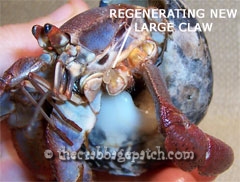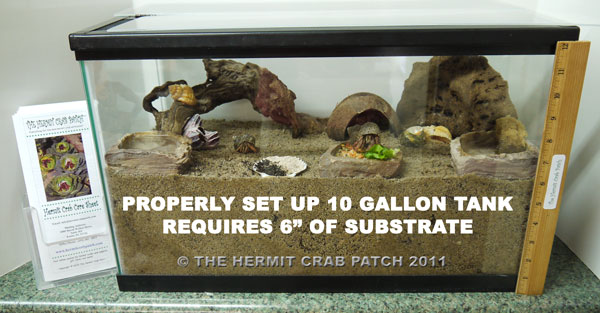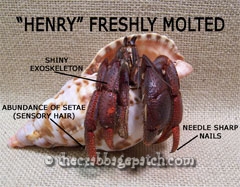Molting is the process by which a hermit crab grows. It involves shedding of the exoskeleton and for a short time afterward the crab is unable to move until it regains muscle control and the new exoskeleton hardens up. At this point the crab will begin eating the old exoskeleton which helps to recycle calcium and other minerals necessary for the new exoskeletons health and rigidity. Because hermit crabs are vulnerable during this time, they tend to bury underground (shell and all!) in the

wild for protection, insulation and darkness necessary to allow the molting hormone (MH) to be secreted so that the shedding process known as ecdysis can begin.
Prior to burying, the hermit crab will begin to store water and nutrients which can be seen on larger crabs as a gray-black bubble located on the left underside of the crabs abdomen. The water will be used to expand the exoskeleton during ecdysis and the stored nutrients will sustain the crab while buried. Salt plays an important role in the shedding process. Hermit crabs need to store salts in addition to water in order to build up hydrostatic pressure necessary to burst open their exoskeleton so that they can pull out of it. Hermit crabs usually begin to show signs that an impending molt is near.
Some of the common signs and symptoms to watch for are as follows:
- Excessive digging behavior: this will be noticed in crabitats that are not set up properly with a substrate deep enough for the molting crab to bury in (i.e. a couple of inches of sand or gravel). In nature hermit crabs bury underground to molt. They need extended darkness so that the molting hormone can be secreted and protection from predators and the elements during this vulnerable and critical time. If crabs are not provided substrate (preferably sand or sandy soil) that is deep enough and moist enough to completely bury, they may attempt to molt on the surface. Small crabs may be able to accomplish this feat, but the danger lies in the possibility of other crabs scavenging the freshly molted crab who is unable to move until he regains muscle control and hardens up. A freshly molted crab has an enticing smell to other crabs, who may take advantage of the opportunity for a free meal. Jumbo crabs have an increasingly difficult time molting as they get older. It is difficult for a jumbo to survive a surface molt.
- Excessive time spent in both the fresh water and salt water dishes: Crabs getting ready to molt need to store an abundance of water that they can use not only for survival, but in order to swell and break open their exoskeletons. You may notice the gray-black bubble on your crabs abdomen I mentioned above. This indicates that the crab is storing food and water reserves that will be used to survive the molt. Other than that reserve and eating its old exoskeleton, a molting crab will remain buried and doesn't come up for food and water until it's completely finished with the process.
- Changing into a smaller shell: this one surprises people! You would tend to think a crab getting ready to molt (grow) would actively seek out a bigger shell. Often times, just the opposite happens. Instinctively, a crab getting ready to molt knows that a bigger shell with a larger opening will get bogged down with sand when the crab buries down. To avoid this, crabs often tend to move into a more tightly fitting shell before burying themselves. The freshly molted crab is actually smaller than it was before shedding and usually about a month or so after coming up will begin to actively seek a larger shell as the new exoskeleton begins to bulk up.
- Activity level declines: prior to molting, a crab will begin to become less active. Especially crabs that have put off
 molting because conditions weren't right. They may stay tucked within their shells and show very little interest in other crabs or even feeding until after molting.
molting because conditions weren't right. They may stay tucked within their shells and show very little interest in other crabs or even feeding until after molting.
- Other visual signs: a crab that needs to molt will often times have dull looking cloudy eyes and a chalky appearance to their exoskeleton. Also, crabs that have lost an appendage will have a pronounced "limb bud" just prior to molting. This limb bud is a newly regenerated leg or claw that is forming in a soft white opaque sac and will unfold into a smaller version of the original limb upon molting. Eventually the appendage will grow to normal size after 2-3 molts.
THE MOLTING CYCLE The molting cycle is comprised of four stages that govern the growth of a hermit crab.
- Proecdysis also known as pre-molt: the period before molting when the new exoskeleton is deposited below the old one. Also any lost appendages will begin to regenerate as limb buds that will unfold at the time of molting. During this time the crab is actively storing salts which will be necessary in the shedding process as well as storing water and food reserves.
- Ecdysis or molt: the active shedding of the exoskeleton. During this stage which is the shortest in duration of the four, salts and water are used by the crab's hemolymph (similar to our blood) to build up hydrostatic pressure and crack the exoskeleton to be able to withdraw from it. Land hermit crabs molt while in their shell which acts as a mold for the soft crab.
- Metecdysis or post-molt: the phase during which the freshly molted crab begins to harden up and recover movement ability. The crab will consume his exoskeleton to recycle necessary minerals and salts to aid in the calcification process.
-
Anecdysis also referred to as intermolt: the longest period during which the exoskeleton will begin to bulk up as calcium and minerals are consumed and deposited. A sort of period of rest between the end of one molt and beginning of the next. As the crab grows, this phase gradually increases in length. A small growing hermit crab will molt more frequently than a larger crab.
For years I kept a molting diary where I documented all of my pet crabs molts. By doing this I was able to learn a variety of information that can be applied as a general rule. For instance, small crabs are actively growing and molting more frequently but tend not to remain buried as long as older larger crabs. Following is a basic time line regarding size, molting length and frequency that I took from the information that I gathered, for tiny crabs I can't answer frequency. This is a guideline and not engraved in stone.
Tiny crabs about the size of a dime will bury for about 2 weeks, many times per year.
Small crabs about the size of a quarter will bury up to a month, 3-4 times per year.
Medium crabs about the size of a golf ball will bury for 1-2 months, 1-2 times per year.
Large crabs about the size of a tennis ball will bury for 2-3 months, 1 time per year.
Jumbo crabs about the size of a baseball or larger will bury for 3 months, 1 time per year or year and a half.
MY MOLTING PHILOSOPHY
Hermit crabs are wild creatures and I believe they should be kept in conditions that honor and simulate their natural environment. In nature, land hermit crabs bury to protect themselves during the stressful time of molting. By digging a "cave" below ground they are able to obtain extended darkness which triggers the release of the molting hormone (MH) which in turn causes the shedding process to begin. Burying also provides the crab with an isolated and stable environment that is protected from temperature fluctuations, the elements and predators. I believe one of the keys to survival in captivity is to set up your tank so that your crabs can bury whenever they need to molt. I feel a sand or sand/soil substrate that is moist enough AND deep enough so that your largest crab can completely bury is critical to long-term survival and keeping your crabs stress level in regards to molting minimal.

I personally feel that an isolation tank is unnecessary and can even result in more stress or death.
Since hermit crabs are nocturnal, many times crabs getting ready to molt will bury down at night (while we are sleeping). If they are not provided with the ability to do so, they perceive the environmental conditions to be unfavorable and a second hormone, known as molt inhibiting hormone (MIH) is secreted to attempt to ward off molting until conditions become favorable and they can bury, a sort of short term survival mechanism. The problem is, if
 conditions don't become favorable to bury, they continue to secrete levels of MIH and eventually this hormone builds to a level within the crab's body to where it can no longer physically survive a molt and the crab dies. Unfortunately, this happens in many pet shops and mall kiosks where crabs are not given the proper substrate and depth to bury when they need to molt. I've often wondered, how does one determine the proper timing of placing a crab that needs to molt in the separate isolation tank, especially when leading a busy life and trying to get a decent nights sleep?! I think the crab knows best when he is ready to begin the process and well intentioned owners should trust his instinct and not try to second guess and predict the timing of such a critical, hormonally controlled event such as molting.
conditions don't become favorable to bury, they continue to secrete levels of MIH and eventually this hormone builds to a level within the crab's body to where it can no longer physically survive a molt and the crab dies. Unfortunately, this happens in many pet shops and mall kiosks where crabs are not given the proper substrate and depth to bury when they need to molt. I've often wondered, how does one determine the proper timing of placing a crab that needs to molt in the separate isolation tank, especially when leading a busy life and trying to get a decent nights sleep?! I think the crab knows best when he is ready to begin the process and well intentioned owners should trust his instinct and not try to second guess and predict the timing of such a critical, hormonally controlled event such as molting.
When we try to control and oversee aspects of our crabs welfare that is better left to the crab itself, even if done in a well-meaning way, the outcome can be disastrous. Just as a butterfly helped from it's cocoon will not survive. Our responsibility to these creatures in our care is to provide them with what they need to survive. What better way to do that than to provide what they would have if they were living in nature, especially when it works!
Since learning 12 years ago how hermit crabs in nature bury below ground to molt, I have pet crabs that have survived since then. Now a process that I used to fear and consider a death sentence, is just a minor inconvenience and a miracle of nature.
 wild for protection, insulation and darkness necessary to allow the molting hormone (MH) to be secreted so that the shedding process known as ecdysis can begin.
wild for protection, insulation and darkness necessary to allow the molting hormone (MH) to be secreted so that the shedding process known as ecdysis can begin.  molting because conditions weren't right. They may stay tucked within their shells and show very little interest in other crabs or even feeding until after molting.
molting because conditions weren't right. They may stay tucked within their shells and show very little interest in other crabs or even feeding until after molting.

 conditions don't become favorable to bury, they continue to secrete levels of MIH and eventually this hormone builds to a level within the crab's body to where it can no longer physically survive a molt and the crab dies. Unfortunately, this happens in many pet shops and mall kiosks where crabs are not given the proper substrate and depth to bury when they need to molt. I've often wondered, how does one determine the proper timing of placing a crab that needs to molt in the separate isolation tank, especially when leading a busy life and trying to get a decent nights sleep?! I think the crab knows best when he is ready to begin the process and well intentioned owners should trust his instinct and not try to second guess and predict the timing of such a critical, hormonally controlled event such as molting.
conditions don't become favorable to bury, they continue to secrete levels of MIH and eventually this hormone builds to a level within the crab's body to where it can no longer physically survive a molt and the crab dies. Unfortunately, this happens in many pet shops and mall kiosks where crabs are not given the proper substrate and depth to bury when they need to molt. I've often wondered, how does one determine the proper timing of placing a crab that needs to molt in the separate isolation tank, especially when leading a busy life and trying to get a decent nights sleep?! I think the crab knows best when he is ready to begin the process and well intentioned owners should trust his instinct and not try to second guess and predict the timing of such a critical, hormonally controlled event such as molting.